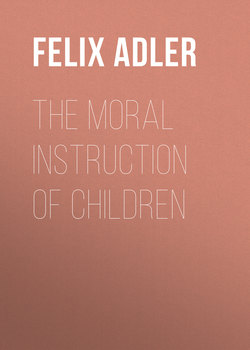Читать книгу The Moral Instruction of Children - Felix Adler, Felix Adler - Страница 8
PRIMARY COURSE
ОглавлениеVI.
THE USE OF FAIRY TALES
There has been and still is considerable difference of opinion among educators as to the value of fairy tales. I venture to think that, as in many other cases, the cause of the quarrel is what logicians call an undistributed middle– in other words, that the parties to the dispute have each a different kind of fairy tale in mind. This species of literature can be divided broadly into two classes – one consisting of tales which ought to be rejected because they are really harmful, and children ought to be protected from their bad influence, the other of tales which have a most beautiful and elevating effect, and which we can not possibly afford to leave unutilized.
The chief pedagogic value they possess is that they exercise and cultivate the imagination. Now, the imagination is a most powerful auxiliary in the development of the mind and will. The familiar anecdote related of Marie Antoinette, who is said to have asked why the people did not eat cake when she was told that they were in want of bread, indicates a deficiency of imagination. Brought up amid the splendor of courts, surrounded by luxury, she could not put herself in the place of those who lack the very necessaries. Much of the selfishness of the world is due not to actual hard-heartedness, but to a similar lack of imaginative power. It is difficult for the happy to realize the needs of the miserable. Did they realize those needs, they would in many cases be melted to pity and roused to help. The faculty of putting one's self in the place of others is therefore of great, though indirect, service to the cause of morality, and this faculty may be cultivated by means of fairy tales. As they follow intently the progress of the story, the young listeners are constantly called upon to place themselves in the situations in which they have never been, to imagine trials, dangers, difficulties, such as they have never experienced, to reproduce in themselves, for instance, such feelings as that of being alone in the wide world, of being separated from father's and mother's love, of being hungry and without bread, exposed to enemies without protection, etc. Thus their sympathy in a variety of forms is aroused.
In the next place, fairy tales stimulate the idealizing tendency. What were life worth without ideals! How could hope or even religion germinate in the human heart were we not able to confront the disappointing present with visions which represent the fulfillment of our desires. "Faith," says Paul, "is the confidence of things hoped for, the certainty of things not seen." Thus faith itself can not abide unless supported by a vivid idealism. It is true, the ideals of childhood are childish. In the story called Das Marienkind we hear of the little daughter of a poor wood-cutter who was taken up bodily into heaven. There she ate sweetmeats and drank cream every day and wore dresses made of gold, and the angels played with her. Sweetmeats and cream in plenty and golden dresses and dear little angels to play with may represent the ideals of a young child, and these are materialistic enough. But I hold nevertheless that something – nay, much – has been gained if a child has learned to take the wishes out of its heart, as it were, and to project them on the screen of fancy. As it grows up to manhood, the wishes will become more spiritual, and the ideals, too, will become correspondingly elevated. In speaking of fairy tales I have in mind chiefly the German Märchen
